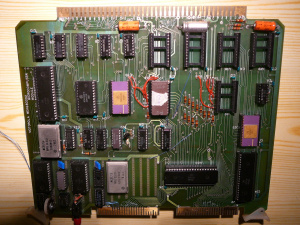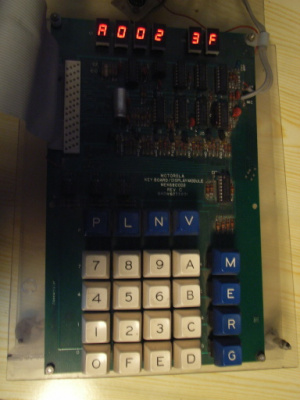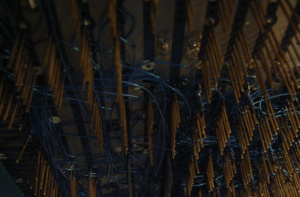Difference between revisions of "MEK6800"
| (13 intermediate revisions by the same user not shown) | |||
| Line 1: | Line 1: | ||
| + | [[File:P1010859.resized.JPG|thumb|]] | ||
[[File:RIMG2953b.JPG|thumb|]] | [[File:RIMG2953b.JPG|thumb|]] | ||
[[File:RIMG2951b.JPG|thumb|]] | [[File:RIMG2951b.JPG|thumb|]] | ||
| + | |||
| + | == Specification == | ||
| + | |||
| + | Motorola MEK68000D2 Evaluation Kit | ||
| + | * microcomputer module 84DW6232X01 | ||
| + | ** No extra RAM on board, U14,U16,U18,U19 are empty but modified to have RAM from 0000 via exorciser bus. | ||
| + | ** No extra EPROM; U10,U12 are empty | ||
| + | ** Some extra circuits: 2 6850's and a clock, perhaps an RS232 interface. | ||
| + | * keyboard/display module 84DW6233X01 | ||
| + | * EXORciser backplane | ||
| + | * Memory module (wire-wrapped): 16 x 4116 (32KB) | ||
| + | * Lots of documentation | ||
| + | * some parts that I haven't figured out yet | ||
| + | ** micro-cassette recorder with what looks like an RS232 and a bunch of micro-cassettes | ||
| + | ** some EEPROMs | ||
| + | ** some spare (gold/ceramic!) MK4116 RAMs | ||
| + | ** a keyboard | ||
| + | |||
| + | == Origin == | ||
| + | |||
| + | Picked up for free through an advertisement in the early 1990's. Together with the [[Dual8inchDrive|Matra dual 8" disc drive]] and some other stuff. | ||
== Condition == | == Condition == | ||
| − | + | Working condition, the monitor program is usable. | |
| − | |||
| − | |||
| − | + | The memory module is not yet fully tested. It appears to work but maybe not always, I think I had at least one problem with the lower 16K bank. | |
| − | + | The 'punch' function to save to audio cassette, modulates with to high frequencies (the required 2.4 kHz becomes 4 kHz). | |
| − | + | Three wires are loose of the added components on the processor module. I don't know where they should go. | |
| − | I | + | I'm using a PC ATX power supply to provide 5V. |
== Data Transfer == | == Data Transfer == | ||
| Line 21: | Line 41: | ||
A002M E0G 00G E3G FFE P | A002M E0G 00G E3G FFE P | ||
| − | Just before the P, start recording a wav file. | + | Just before the P, start recording a wav file on the PC. The encoding is Kansas City Standard and can be processed using [http://www.cse.dmu.ac.uk/~mward/martin/software/index.html#CUTS this perl script] |
| + | |||
| + | Now you have a binary file but it still has some headers and framing. These are documented in section 2.7 of the [http://www.bitsavers.org/pdf/motorola/MEK6800D2.pdf manual]. If you strip those you have the actual ROM and it looks exactly the same as the one on [http://www.bitsavers.org/pdf/motorola/jbug.hex bitsavers] | ||
| + | |||
| + | Because the save saves at too high speed, this needs to be adjusted by replaying -40% speed. You can strip off the long mark header to just before the first start bit. For the trailer, you need to leave about 300 ms of marks after the final 'G' character. I don't understand why but otherwise it doesn't work. | ||
| − | |||
== Done == | == Done == | ||
| + | |||
| + | === Memory Repair === | ||
Reseated all chips on the memory board. No change. | Reseated all chips on the memory board. No change. | ||
| + | |||
| + | Found that I simply forgot to connect the -5V and +12V power supply lines that are required by the 4116's... | ||
| + | |||
| + | === EPROMs === | ||
| + | |||
| + | There were EPROMs that came with the kit. 3x 2708 and 4x 2716. | ||
| + | |||
| + | I figured that the U10 (address C000) is wired for a 2716 and U12 (at 6000) for a 2708. | ||
| + | |||
| + | I tested them all and found only 2 of them to contain any data. I transferred them. | ||
| + | |||
| + | === Audio interface === | ||
| + | |||
| + | I thought that the load function was broken, but after using the [[LogicAnalyser|Logic Analyser]] and clean test input sine waves I found that all is working. Then compared with an actual recording and then found that the frequencies were incorrect. Simply playing a lower speed works. | ||
| + | |||
| + | == To Do == | ||
| + | |||
| + | Fix the speed issue of the punch function. | ||
| + | |||
| + | == Links == | ||
| + | |||
| + | * [http://bitsavers.trailing-edge.com/pdf/motorola/6800/MEK6800D2.pdf MEK6800D2 manual (PDF)] | ||
| + | * [http://hcvgm.org/Data_Sheets/Motorola/6800%20Assembly%20Language%20Programming%20%28Lance%20Leventhal%29%281978%29.pdf 6800 Programming] | ||
Latest revision as of 11:44, 5 August 2013
Contents
Specification
Motorola MEK68000D2 Evaluation Kit
- microcomputer module 84DW6232X01
- No extra RAM on board, U14,U16,U18,U19 are empty but modified to have RAM from 0000 via exorciser bus.
- No extra EPROM; U10,U12 are empty
- Some extra circuits: 2 6850's and a clock, perhaps an RS232 interface.
- keyboard/display module 84DW6233X01
- EXORciser backplane
- Memory module (wire-wrapped): 16 x 4116 (32KB)
- Lots of documentation
- some parts that I haven't figured out yet
- micro-cassette recorder with what looks like an RS232 and a bunch of micro-cassettes
- some EEPROMs
- some spare (gold/ceramic!) MK4116 RAMs
- a keyboard
Origin
Picked up for free through an advertisement in the early 1990's. Together with the Matra dual 8" disc drive and some other stuff.
Condition
Working condition, the monitor program is usable.
The memory module is not yet fully tested. It appears to work but maybe not always, I think I had at least one problem with the lower 16K bank.
The 'punch' function to save to audio cassette, modulates with to high frequencies (the required 2.4 kHz becomes 4 kHz).
Three wires are loose of the added components on the processor module. I don't know where they should go.
I'm using a PC ATX power supply to provide 5V.
Data Transfer
I have successfully dumped the JBUG ROM using the cassette out. Type this to Punch addresses E000-E3FF:
A002M E0G 00G E3G FFE P
Just before the P, start recording a wav file on the PC. The encoding is Kansas City Standard and can be processed using this perl script
Now you have a binary file but it still has some headers and framing. These are documented in section 2.7 of the manual. If you strip those you have the actual ROM and it looks exactly the same as the one on bitsavers
Because the save saves at too high speed, this needs to be adjusted by replaying -40% speed. You can strip off the long mark header to just before the first start bit. For the trailer, you need to leave about 300 ms of marks after the final 'G' character. I don't understand why but otherwise it doesn't work.
Done
Memory Repair
Reseated all chips on the memory board. No change.
Found that I simply forgot to connect the -5V and +12V power supply lines that are required by the 4116's...
EPROMs
There were EPROMs that came with the kit. 3x 2708 and 4x 2716.
I figured that the U10 (address C000) is wired for a 2716 and U12 (at 6000) for a 2708.
I tested them all and found only 2 of them to contain any data. I transferred them.
Audio interface
I thought that the load function was broken, but after using the Logic Analyser and clean test input sine waves I found that all is working. Then compared with an actual recording and then found that the frequencies were incorrect. Simply playing a lower speed works.
To Do
Fix the speed issue of the punch function.


